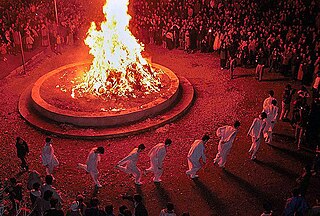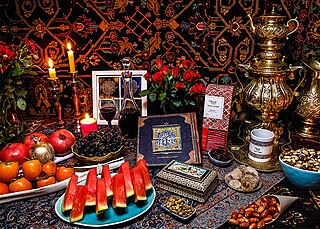
Zoroastrianism, also known as Mazdayasna and Behdin, is an Iranian religion. Among the world's oldest organized faiths, it is based on the teachings of Iranian prophet Zarathustra—commonly known by his Greek name Zoroaster—as set forth in the primary religious text called the Avesta. Zoroastrians exalt an uncreated and benevolent deity of wisdom as the universe's supreme being, commonly referred to as Ahura Mazda. Opposed to Ahura Mazda is Angra Mainyu, who is personified as a destructive spirit and the adversary of all things good. Zoroastrianism combines a dualistic cosmology of good and evil with an eschatology that predicts the ultimate triumph of Ahura Mazda over evil. Opinions vary among scholars as to whether the religion is monotheistic, polytheistic, henotheistic, or a combination of all three. Zoroastrianism shaped Iranian culture and history, while scholars differ on whether it significantly influenced ancient Western philosophy and the Abrahamic religions, or gradually reconciled with other religions and traditions, such as Christianity and Islam.

The Avesta is the primary collection of religious literature of Zoroastrianism from at least the late Sassanid period. It is composed in the Avestan language, with the oldest surviving fragment of a text in the Avestan language dating to 1323 CE.

Adherents of Zoroastrianism use three distinct versions of traditional calendars for liturgical purposes. Those all derive from medieval Iranian calendars and ultimately are based on the Babylonian calendar as used in the Achaemenid empire. Qadimi ("ancient") is a traditional reckoning introduced in 1006. Shahanshahi ("imperial") is a calendar reconstructed from the 10th century text Denkard. Fasli is a term for a 1906 adaptation of the 11th century Jalali calendar following a proposal by Kharshedji Rustomji Cama made in the 1860s.

The Ghost Festival or Hungry Ghost Festival, also known as the Zhongyuan Festival in Taoism and the Yulanpen Festival in Buddhism, is a traditional festival held in certain East and Southeast Asian countries. According to the Chinese calendar, the Ghost Festival is on the 15th night of the seventh month.
Esfand is the twelfth and final month of the Solar Hijri calendar, the official calendar of Iran and Afghanistan. Esfand has twenty-nine days normally, and thirty during leap years. It begins in February and ends in March of the Gregorian calendar. The Afghan Persian name is Hūt; in Pashto it is Kab.

The Iranian religions, also known as the Persian religions, are, in the context of comparative religion, a grouping of religious movements that originated in the Iranian plateau, which accounts for the bulk of what is called "Greater Iran".

The Farāvahār, also called the Foruhār (فروهر) or the Fārre Kiyâni, is one of the most prominent symbols of Zoroastrianism. There is no universal consensus on what it means or stands for, as a variety of interpretations exist. The most common belief is that it depicts the fravaṣ̌i, which is the Zoroastrian concept of one's personal spirit.

Sadeh, is an Iranian festival that dates back to the Achaemenid Empire. Sadeh celebrates 50 days before Nowruz. Sadeh in Persian means "hundred" and refers to one hundred days and nights remains to the beginning of spring. Sadeh is a mid winter festival that was celebrated with grandeur and magnificence in ancient Persia. It was a festivity to honor fire and to defeat the forces of darkness, frost, and cold.
Fravashi is the Avestan term for the Zoroastrian concept of a personal spirit of an individual, whether dead, living, or yet-unborn. The fravashi of an individual sends out the urvan into the material world to fight the battle of good versus evil. On the morning of the fourth day after death, the urvan returns to its fravashi, where its experiences in the material world are collected to assist the next generation in their fight between good and evil.

The Vendidad /ˈvendi'dæd/ or Videvdat or Videvdad is a collection of texts within the greater compendium of the Avesta. However, unlike the other texts of the Avesta, the Vendidad is an ecclesiastical code, not a liturgical manual.
Sepandārmazgān or Espandegān (اسپندگان), is an ancient Iranian day of women with Zoroastrian roots dating back to the first Persian Empire, the Achaemenid Empire. This day is dedicated to Spənta Ārmaiti, the Amesha Spenta who is given the domain of "earth". The date of the festival as observed in the Sassanid era was on the 5th day of the month Spandarmad. When the name of the day and the month of the day were the same, a "name-feast" celebration was always done. According to the testimony of al-Biruni, in the 11th century CE there was a festival when the names of the day and the month were the same. The deity Spandarmad protected the Earth and the "good, chaste and beneficent wife who loves her husband". According to him, the festival used to be dedicated to women, and men would make them "liberal presents", and the custom was still flourishing in some districts of Fahla.

Asha or arta is a Zoroastrian concept with a complex and highly nuanced range of meaning. It is commonly summarized in accord with its contextual implications of 'truth' and 'right', 'order' and 'right working'. It is of cardinal importance to Zoroastrian theology and doctrine. In the moral sphere, aṣ̌a/arta represents what has been called "the decisive confessional concept of Zoroastrianism". The opposite of Avestan aṣ̌a is 𐬛𐬭𐬎𐬘 druj, "deceit, falsehood".

Zoroastrianism has numerous festivals and holy days, all of which are bound to the Zoroastrian calendar. The Shahenshahi and Kadmi variants of the calendar do not intercalate leap years and hence the day of the Gregorian calendar year on which these days are celebrated shifts ahead with time. The third variant of the Zoroastrian calendar, known as either Fasli or Bastani, intercalates according to Gregorian calendar rules and thus remains synchronous with the seasons. For details on the differences, see Zoroastrian calendar.

Sizdah Bedar, also known as Nature's Day, is an Iranian festival held annually on the thirteenth day of Farvardin, the first month of the Iranian calendar (and the first month of spring, during which people spend time picnicking outdoors. It marks the end of the Nowruz holidays in Iran.

Yaldā Night or Chelle Night is an ancient festival in Iran, Afghanistan, Azerbaijan, Tajikistan, Iraqi Kurdistan, Uzbekistan, Turkmenistan, Dagestan and Turkey that is celebrated on the winter solstice. This corresponds to the night of December 20/21 (±1) in the Gregorian calendar, and to the night between the last day of the ninth month (Azar) and the first day of the tenth month (Dey) of the Iranian solar calendar. The festival is celebrated in Iran and the regions of greater Iran, including Azerbaijan, Iraqi Kurdistan, Balochi areas, Afghanistan and Tajikistan. The longest and darkest night of the year is a time when friends and family gather together to eat, drink and read poetry and Shahnameh until well after midnight. Fruits and nuts are eaten and pomegranates and watermelons are particularly significant. The red color in these fruits symbolizes the crimson hues of dawn and the glow of life. The poems of Divan-e Hafez, which can be found in the bookcases of most Iranian families, are read or recited on various occasions such as this festival and Nowruz. Shab-e Yalda was officially added to Iran's List of National Treasures in a special ceremony in 2008.

An Atash Behram is the highest grade of fire that can be placed in a Zoroastrian fire temple as an eternal flame. The other two lower graded fires are Atash Adaran and below Adaran is the Atash Dadgah; these three grades signify the degree of reverence and dignity these are held in. The establishment and consecration of the Atash Behram fire is the most elaborate of all the grades of fire. It involves the gathering of 16 different types of fire, including fire by lightning, fire from a cremation pyre, fire from trades where a furnace is operated, and fires from the hearths as is also the case for the Atash Adaran. Each of the 16 fires is then subject to a purification ritual before it joins the others. A large team of priests is required for the purification and consecration ceremonies, which can take up to a year to complete.

Frawardigan is a ten-day period at the end of the Zoroastrian religious year during which the souls of the dead are commemorated.
Zoroastrianism is recognized in the Baháʼí Faith as one of nine known religions and its scriptures are regarded as predicting the coming of Baháʼu'lláh. Zoroaster is included in the succession of Manifestations of God. The authenticity of the Zend Avesta is seen as uncertain.

The Solar Hijri calendar is the official calendar of Iran. It is a solar calendar and is the one Iranian calendar that is the most similar to the Gregorian calendar, being based on the Earth's orbit around the Sun. It begins on the March equinox as determined by the astronomical calculation for the Iran Standard Time meridian and has years of 365 or 366 days. It is sometimes also called the Shamsi calendar and Khorshidi calendar. It is abbreviated as SH, HS or, sometimes as AHSh, while the lunar Hijri calendar is usually abbreviated as AH. The solar Hijri calendar predominates in Shia Islam whereas the lunar Hijri calendar predominates in Sunni Islam.
Khorram Rooz is the first day of Dey, the 10th month of the Iranian calendar. Both religious and non-religious traditions are associated with this day, such as the ancient Persians considering it the first day of the winter and rebirth of the sun.









